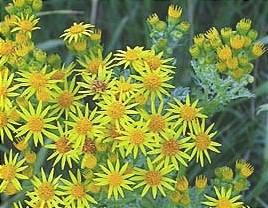Tansy ragwort
Senicio jacoaea L.
Keys to Identification
- Multiple yellow flowers in inflorescence.
- Stems may be purplish-red.
- Disk flowers have black tips.
Family
Sunflower (Asteraceae)
Other Names
Stinking Willie, Tansy Butterweed
USDA Code
SEJA
Legal Status
Colorado Noxious Weed List A
Identification
Lifecycle
Biennial or short-lived perennial
Growth form
Forb
Flower
Yellow. July-September. Has both ray and disk flowers.
Seeds/Fruit
Disk flowers are hairy. Ray flowers are smooth.
Leaves
2-8 in long. Multi-lobed.
Stems
Mature plants 1-6 ft tall. Stems have downy hairs.
Roots
Taproot with fleshy side roots.
Similar Species
Exotics
None known.
Natives
Senicio sp., Grounsel
Impacts
Agricultural
Toxic to livestock.
Ecological
Displaces native vegetation.
Habitat and Distribution
General requirements
Found in pastures, along rights-of- way and disturbed places. Prefers moist soils.
Distribution
Found in California, Idaho, Illinois, Maine, Massachusetts, Michigan, Montana, New Jersey, New York, Oregon, Pennsylvania, Washington. Recently found in Alaska. Not known to occur in Colorado.
Historical
Tansy ragwort is native to Europe. Known in North America since the early 1900’s.
Biology/Ecology
Life cycle
Tansy ragwort generally produces a basal rosette the first year, and flowers the following year. The plants are prolific bloomers and produce large quantities of seed from July through September.
Mode of reproduction
Seed. May sprout from root fragments.
Seed production
Produces up to 150,000 seeds.
Seed bank
The majority of the seeds will germinate the following year, but some seeds may remain dormant for several years.
Dispersal
Wind
References
Whitson, T.D.(ed.), L.C. Burrill, S.A. Dewey, D.W. Cudney, B.E. Nelson, R.D. Lee, R. Parker. 2001. Weeds of the West. Western Society of Weed Science, in cooperation with the Western United States Land Grant Universities Cooperative Extension Services, Newark CA.
Growers Weed Identification Handbook, University of California Publication 4030, pg. WI-212


